A Gentleman’s Colt
Pocket Hammerless Model
The First Gold Inlaid Model M
by
Sam Lisker
Several years ago while attending the Portland, Oregon
CCA show, I spotted on a collector’s table a most interesting Colt Model
1903 Pocket hammerless pistol (Model M) in .32 ACP. The pistol, serial
number 2822, had some engraving and unique gold inlays on the slide and
frame, the initials “D.H.P” inlaid on the engraved grip safety, a blued
finish and plain mother of pearl grips. Accompanying the pistol was a
factory letter confirming the features and indicating that the pistol, a
single gun shipment, was shipped to Browning Bros., Ogden, Utah on December
15, 1903.
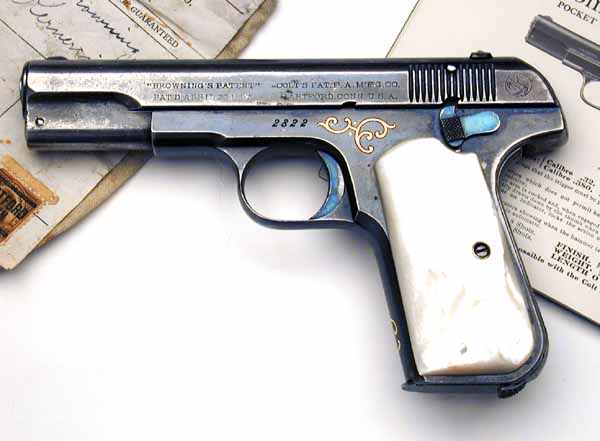
I spoke briefly to the collector and asked if it was
for sale. He indicated that it was not, so I gave him my information and
asked him to contact me if he ever changed his mind.
Several years passed and the San Francisco CCA show was just around the
corner. About a week before the show, the owner called me, asked if I was
planning on attending the CCA show and indicated that he was ready to sell
his gold inlaid Colt .32 ACP Pocket Hammerless model.
At the show, I purchased the gun. When I got the Colt back to Virginia (via
Birmingham, England thanks to American Airlines – but that’s another
story!), I immediately set out to learn as much as I could about my new
acquisition. All I had to go on was the information in the Colt letter to
begin my search, as the collector from whom I bought it indicated that it
was purchased at a Portland gun show from a walk-in.
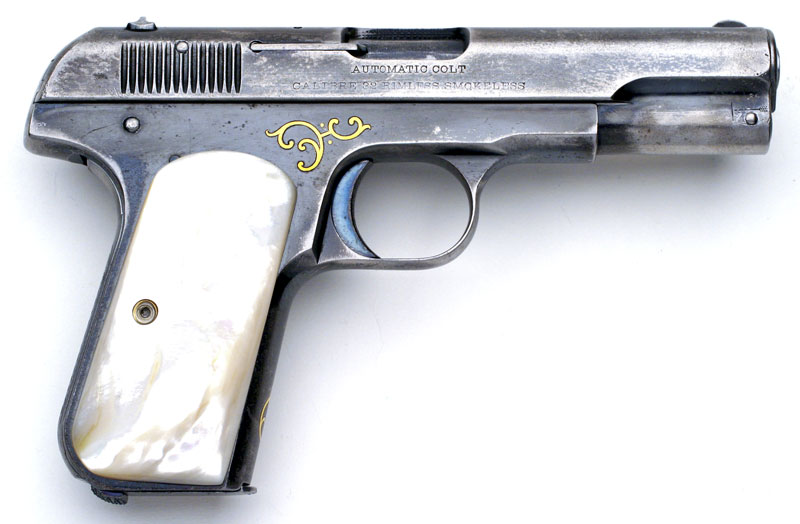
The first resource I explored was the internet. It was a real gamble as all
I had were three gold initials, a shipping date, the name of a retailer and
a City and State. My broad search began looking for Ogden, Utah history,
figuring that the person who could afford such a gun in 1903 must have been
well known figure in the community. The first site I searched was the
official Ogden City website. When I read the following paragraph on the
history page, I could see a very faint light at the end of a potentially
long tunnel:
“Ogden began to look for commerce. The establishment of the Farr's grist and
saw mills in Ogden and the Daniel Burch's mills on the Weber River were
major occurrences around 1850. In 1863, Jonathan Browning, James Horrocks,
Arthur Stayner, William Pidcock and Samual Horrocks opened commercial
businesses. David Peery later established the Ogden Branch of ZCMI in 1868.
Fred J. Kiesel established the first industrial development in town. Later a
woolen factory was constructed at the mouth of Ogden Canyon by Randall,
Pugsley, Farr and Nell.”

The information I found had potential -- if only I
could find David Peery’s middle initial. I then searched the internet for
David Peery and the light got a little brighter. The next resource I located
was the informative Peery Family genealogy web site maintained by Paul D.
Peery, the grandson of David Harold Peery. The connection was looking
better, but I could not overlook the possibility that the match of the
initials DHP to David Harold Peery in the city of Ogden was just a
coincidence.
As I read the information on the Peery web site about David Harold Peery, I
was beginning to believe that I had stumbled upon the information that might
just lead me to discovering the original owner of the Colt. I learned that
David Harold Peery had ten children, seven sons and three daughters. From
oldest to youngest, the sons names were David Henry Peery, Joseph Stras
Peery, Horace Eldredge Peery, John Harold Peery, Simon Francis Peery, Louis
Hyrum Peery and Harman Ward Peery. The three daughters were Nancy May Peery,
Eleanor Virginia Peery and Louise Margaret Peery. David Henry Peery was the
firstborn. Paul D. Peery, son of Joseph Stras Peery, is a nephew of his
father's nine siblings.
Some of the most interesting reading came from “Life of Elizabeth Letitia
Higginbotham Peery, Dictated by Elizabeth Letitia Higginbotham Peery, July
25-26, 1907 at home in Ogden, Weber County, Utah.” The parents of Elizabeth
Letitia Higginbotham Peery moved from Tazewell County, Virginia to Nauvoo,
Illinois where she was born. After awhile, this family returned to Tazewell
County upon the death of a family member who had remained in Tazewell
County. Her parents remained there for the rest of their lives.
When David Harold Peery led surviving family members (many of whom died of
typhoid) during the Civil War from Burke's Garden, Tazewell County,
Virginia, they went to Omaha, Nebraska, where they eventually embarked on
the trip across the plains in three covered wagons they had purchased. Omaha
was the embarkation point for the Mormon Trail. At that time, David Harold
Peery and Elizabeth Letitia were not married. She was the younger sister of
David's first wife, Nancy Campbel [sic] Higginbotham.
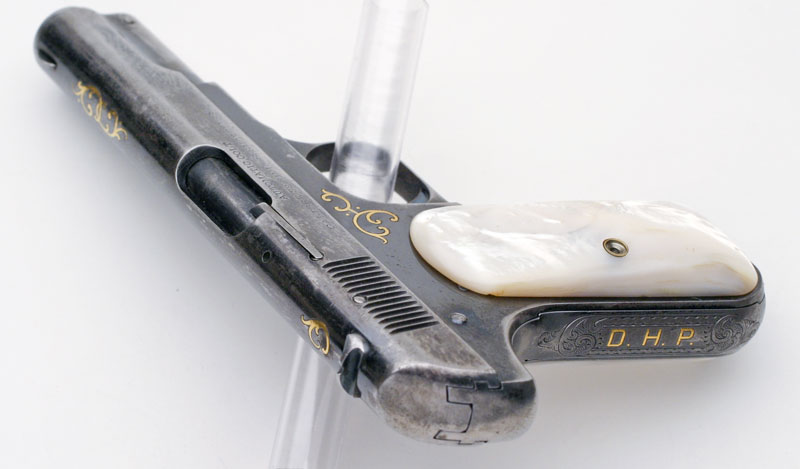
It was not until a year or so after they arrived in
Utah, that David Harold and Elizabeth Letitia were married. They were living
in the Cottonwood section of Salt Lake County at the time, where their first
child, David Henry Peery, was born in 1866. They relocated to Ogden, Weber
County, Utah where their second child, Joseph Stras Peery, was born in 1868.
The document is quite lengthy and presents a very vivid account of the
experiences and hardships faced by the Peery family during their journey
from Tazewell County, Virginia through Omaha, Nebraska to Salt lake City,
Utah. “Letitia” Peery (as she was known by family and friends) included in
the record the births and deaths of all of her children. When I read the
account, of particular interest was the name of her first born:
“We returned to Cottonwood where we remained until the fall of 1866. My son,
David Henry Peery, was born at 5 o'clock A.M. Friday, April 13, 1866 in
Holladay, Utah; he weighed 8 1/4 lbs. In those days there were no doctors,
and I was confined to bed for about one month. Then I gradually became
stronger, and my health gradually returned after the birth of my children,
until now I am strong and well for a woman of my age. I sleep well and eat
well.”
Now I had two possible owners of the Colt: David Harold Peery and David
Henry Peery.
Before I kept pursuing information on David H. Peery, I wrote to the Weber
County Library and asked them to research the city directory from 1883 –
1905 to see if there were any other residents with the initials D.H.P. As
luck would have it, David H. Peery, both father and son, were the only
individuals listed in the in Odgen city directory with the initials D.H.P.
With this new information, I continued my search. From the written account
provided by Elizabeth Letitia Peery, David Harold Peery clearly had the
means to afford such an embellished Colt:
“My husband had been a successful merchant in Virginia before the war. He
had accumulated by his own endeavors a fortune of about $50,000, and was
considered one of the best businessmen in the South. He had a splendid
standing with the wholesale merchants of Baltimore and other Centers. In
Virginia, he first started in business at Clear Fork, and people came from
miles around to trade with him. Afterwards he moved to Burke's Garden,
Virginia; people would come from forty miles around to trade with him. In
that backwoods country, he worked up a large business that was remarkable.”
Early on in Ogden, David Harold Peery worked for the owner of a merchandise
store. He later bought the man out, brought in a close friend and renamed
the store Peery & Herrick. A few years later, the Zions Cooperative
Mercantile Institution (Z.C.M.I.) opened a store and Brigham Young asked
David Harold Peery to run it. He and his partner agreed. Peery & Herrick was
liquidated, selling its inventory to Z.C.M.I.:
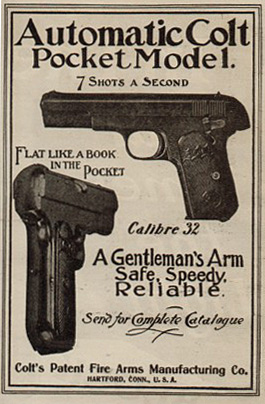 “After they had been in business two or three years, President Young opened
the Z.C.M.I. [Zions Cooperative Mercantile Institution] in Ogden, and wished D.H. Peery to become the manager. The firm of Peery & Herrick was dissolved,
the goods were sold to Z.C.M.I., with D.H. Peery as manager at a salary of
$500 per month. This was the most flourishing time of the Z.C.M.I. in Ogden.
Mr. Peery worked very hard. He went to work promptly at 7 o'clock in the
morning, and worked up a trade of $800,000 a year. They did a large
wholesale business throughout the surrounding counties. Merchants would come
from Idaho and the different counties to do business with him. The store was
very prosperous, and paid good dividends.” “After they had been in business two or three years, President Young opened
the Z.C.M.I. [Zions Cooperative Mercantile Institution] in Ogden, and wished D.H. Peery to become the manager. The firm of Peery & Herrick was dissolved,
the goods were sold to Z.C.M.I., with D.H. Peery as manager at a salary of
$500 per month. This was the most flourishing time of the Z.C.M.I. in Ogden.
Mr. Peery worked very hard. He went to work promptly at 7 o'clock in the
morning, and worked up a trade of $800,000 a year. They did a large
wholesale business throughout the surrounding counties. Merchants would come
from Idaho and the different counties to do business with him. The store was
very prosperous, and paid good dividends.”
There was also a paragraph in the document that referenced an early business
relationship (ca. 1873 – 1876) with John M. Browning’s father, Jonathan
Browning:
“At the suggestion of President Young, Mr. Horace Eldredge (a prominent
merchant and banker in Salt Lake City, and a particular friend of my
husband) and Mr. Peery bought property on Fifth Street between Main and
Spring Streets, now the property on 25th Street between Washington and Adams
Avenues. President Young wished them to buy the property to aid Brother
Jonathan Browning, who was in hard financial condition at the time.
President Young stated to them that if they bought the property, they would
never lose anything by it. They did so, and sold the corner lot soon
thereafter for more than they had paid for the whole piece. (It is on block
twenty-six, the center block of Ogden.)”
David Harold Peery, a successful, energetic leader and entrepreneur, became
involved in starting several businesses in Ogden, including a bank,
newspaper, mill and more. At one time he served as Mayor of Ogden. He had a
sterling reputation and business acumen,
enabling him to amass financial wealth over the years. In his later years,
he built a mansion in Ogden that was completed in 1893 at a cost of $60,000.
The Virginia, as it was known, was an architectural masterpiece that
featured a tower, ballroom, many fireplaces and a porch surrounding most of
the house. It is estimated that the cost in 2002 dollars would be in the
$2-4 million range:
“In 1893, we moved into our new residence on the corner of 24th Street and
Adams Avenue in Ogden. This residence was built by D.H. Peery as a monument.
It took two years to build it, and it cost about $60,000. The hard wood in
"The Virginia," the name given to the residence, cost $10,000. It was put in
by Andrews & Co. of Chicago. The hard wood work is among the best of its
kind.”
“Each room is finished in different hard-wood. The roof and cornices and
porch are made of copper, and the pillars are stone. The house is large, too
large for a residence. After the death of my husband I built myself a small
house immediately South of the Virginia, which suits my needs much better.”
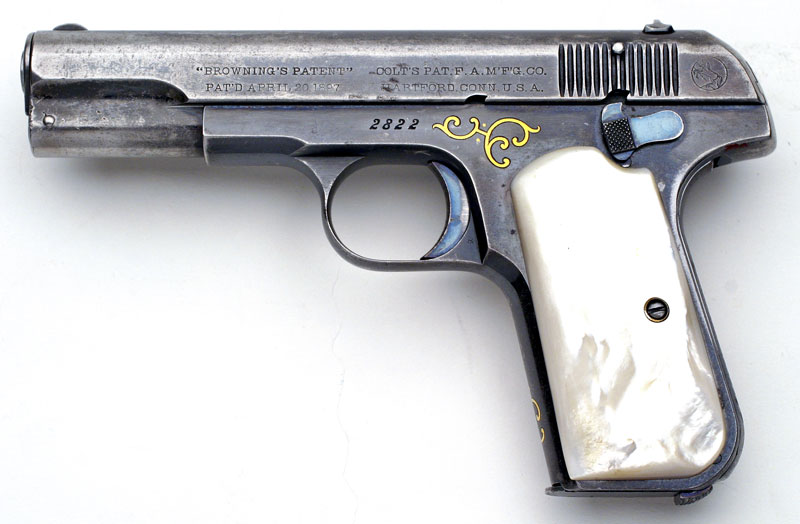
After reading this information, I was certain that David Harold Peery was
the original owner of the Colt. There was just one problem. David Harold
Peery was born on 16 May 1824 and died 17 Sep 1901 – a little more than two
years before the gun was shipped.
This left just one potential owner in the Peery family – David Harold
Peery’s son, David Henry Peery. David Henry Peery’s nephew, Paul Peery, in
written correspondence provided me with a great deal of history about his
uncle:
“I will now relate off the top of my head some information about David Henry
Peery, my uncle, the firstborn in the Ogden Peery Family. My father, Joseph
Stras Peery, was the second child, born in 1868.
David Henry Peery, also known as David H. Peery, and Henry, was a highly
active businessman. While he was born and raised in Ogden, he moved to Salt
Lake City where he became prominently active in the business community.
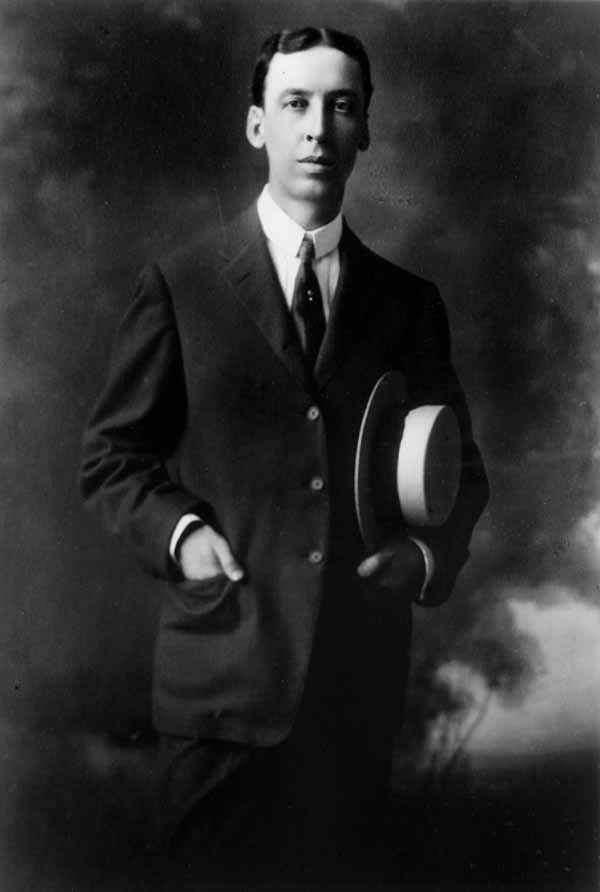
Photo of David Henry Peery Alta Club Collection p. 0245
#185
Special Collections Dept., J. Willard Marriott Library, University of Utah
I have seen his name as a member of several of the
private men's clubs in Salt Lake City at the time, including the current
Alta Club, Salt Lake's leading private downtown club. Uncle Henry, as we
refer to him, was President of the Salt Lake Mining Exchange, and may have
been a founder, as I recall. I have a clipping with a feature story of the
exchange and his picture. He invested in mining stocks, both in Utah and
Nevada, according to this article.
Henry was also active in Democratic politics in Utah. Indeed, from little
Utah he was a member of the Democratic National Committee. He was in the
group along with Samuel Newhouse, who may have been influenced by Henry to
build the Newhouse Hotel in downtown Salt Lake City. The Hotel was
refurbished in the 1950s, and was later torn down, probably in the 1970s or
1980s, to free up the land, which is still just a flat, open space today.
During an illness that came upon him rather quickly, Henry went to Los
Angeles to be in better weather conditions. Shortly thereafter, and while
staying at a hotel, he died. The local Salt Lake City newspapers provided a
daily running account of his condition. When he died, the papers covered the
story like a blanket.
Numerous telegrams regarding his death were received from the East. They
were in the possession of my cousin in Menlo Park, California. Business and
visiting cards he had accumulated were in her possession as well. I saw them
and went through a scrapbook that contained many clippings of Henry's life.
If you wonder whether or not this D.H.P. had the means and reason to own a
Colt pistol, I would bet on it. Relative to other Utah families, the Peerys
were well off. His father, David Harold Peery (D.H. Peery) was an
entrepreneur engaged in many business activities, beginning with department
store retailing. He began a mill, which burned down. He rebuilt it with the
latest imported machinery. He began a bank. He loaned people money on their
word. He became the leading religious leader in the Ogden, Weber County
region, selected by Brigham Young. His roots were in Virginia.
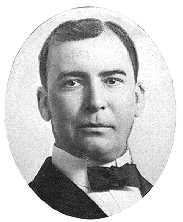 Paul Peery also furnished the following excerpt from his father’s [Joseph
Stras Peery] autobiography regarding his father’s brother, David Henry Peery: Paul Peery also furnished the following excerpt from his father’s [Joseph
Stras Peery] autobiography regarding his father’s brother, David Henry Peery:
“My brother, David Henry Peery, died at Los Angeles, California, December 6,
1907 of Bright’s Disease. He suffered greatly during the last few months of
his life with headaches. Henry accumulated a fortune of about $200,000
during the last two years of his life in the mining business. He left his
estate to be equally divided among his mother and brothers and sisters,
including Mrs. C.C. Richards, but excepting myself. To me he left one dollar
stating that “Joseph S. Peery has ample means of his own.” Henry left many
loyal friends. He was a strong character and had a brilliant quick mind.”
David Henry Peery is buried near his parents in the Peery Family Plot, Ogden
City Cemetery, Ogden, Weber County, Utah.

Aside from the ownership history associated with Colt Model 1903 .32 ACP
serial number 2822, this pistol has some unique characteristics among guns
of this type. It’s the first gold inlaid example of this model and it’s also
the first gun that letters with mother of pearl grips. Serial number “00” is
recorded as having mother of pearl grips, but it was shipped approximately
five years after 2822. It’s also just 1 of 14 factory gold inlaid examples
of this model. The style of engraving and inlay are also very unique as they
were done before there were any defined patterns for such work.
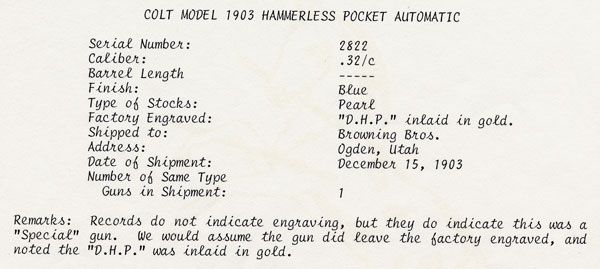
The gun was shipped on December 15, 1903 – given the business relationship
between the Peerys and the Brownings, could it have been a Christmas present
from John M. Browning to David Henry Peery? Or perhaps it was a Christmas
present from another member of the Peery family. My research will continue.
However, the occasion for such a deluxe Colt pocket hammerless model may
remain a mystery.
(I would like to extend sincere thanks Paul D. Peery for his many
contributions and for his availability as a resource for this article - SL)
Bibliography:
- Colt Historical Letter for 1903 Pocket Hammerless Model serial number 2822
- Ogden City Web Site (http://www.ogdencity.com)
- Email correspondence with Paul D. Peery
- Peery Family History Home Page (http://www.cc.utah.edu/~pdp7277/)
- Written correspondence with Weber County Library, Ogden, Utah, 11/4/99.
- Life of Elizabeth Letitia Higginbotham Peery, Dictated by Elizabeth
Letitia Higginbotham Peery, July 25-26, 1907 at home in Ogden, Weber County,
Utah.
Photo of David Henry Peery, Alta Club Collection p. 0245 #185
Special Collections Dept., J. Willard Marriott Library, University of Utah
|